
|   |

|   |
Anveshan - An insightful journey through dance - Dr. Meenakshi Iyer Gangopadhyay e-mail: drmeenakshiiyer@yahoo.co.in April 21, 2024 Rasadhwani - an artistic organization based in Ahmedabad, which has blossomed into a cultural hub under the able guidance of its Artistic Director, Dr. Uma Anantani - a senior dancer, teacher, choreographer and dance academician - presented 'Anveshan' - a collection of three presentations, featuring a team of three brilliant, energetic and talented Bharatanatyam dancers on 7th April 2024 at MES Auditorium, Pune. The senior most among them was Shivangee Vikram, daughter and disciple of Dr. Uma Anantani, who further pursued her Master of Performing Arts at Nalanda Nritya Kala Mahavidyalaya, Mumbai. She was accompanied by Mrinalini Mishra and Khushi Langalia, senior dancers of the Rasadhwani team with the support of Vyom Arts Management Venture. 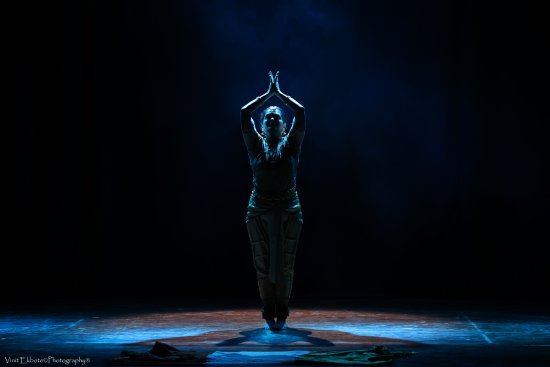 Chakra Alarippu Anveshan is the journey of man from without to within. The journey has always been from 'saguna' to 'nirguna' - from 'form' to the 'formless' - a lofty concept that is not easy to understand. As such, various mediums have been chosen as paths to this mystical journey. Anveshan is an exploration through the language of dance. The first presentation was the Chakra Alarippu by Shivangee Vikram, conceived by Uma Anantani and Shivangee. The mridangam support and recitation of the sollus were by Satish Krishnamurthy (Mumbai) and the music arrangement and vocal by Jayan Nair (Ahmedabad). The Chakra Alarippu has a unique tala pattern combining all the Pancha Jaatis in one avartana, and as such, each avartana has 28 aksharas. The ancient Indian seers visualized various symbols of worship such as mantra, yantra and mudra to communicate with the Supreme. This Chakra Alarippu is conceptualized as a manifestation of this concealed symbolism. The various chakras or energy centres in the human body represent the pancha mahabhutas, animals, sounds etc. The five chakras that were represented through the Chakra Alarippu were - Mooladhara (element-Prithvi, animal-gaja and the sound-'lam'), Svadhishthana (element-Jala, animal-crocodile and the sound-'vam'), Manipura (element-Agni, animal-ram and the sound - 'ram'), Vishuddha (element-Vayu, animal- deer and the sound-'yam'), and Anahata (element- Akasha, and the sound - 'hum'). The Chakra Alarippu began with a shloka in praise of Mother Goddess - the female energy and the cause of creation, followed by the regular movements of the eyes, neck, shoulders executed crisply by Shivangee. The entire concept was aesthetically brought out through nritta. Each stage of the awakening of the Kundalini through the various chakras was presented with the beautifully visualized dance choreography ably supported by the superb music and lighting. Especially, the finale of the Alarippu rendered to the brisk recitation of the sollus, the deep metallic sound of the ghatam and the innovative, powerful lighting was expressive of the final awakening of the Kundalini - Its merging with the Supreme! 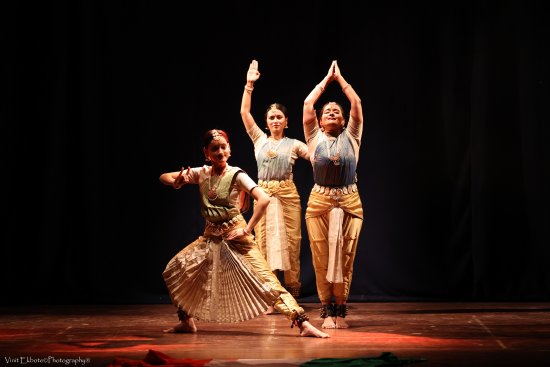 Nandi moving aside The 2nd presentation was the saint-poet Kabir's poem "Moko kahan dhundhe re bandhe..." A thought provoking, inspirational poem in Hindi, it reflects Kabir's contemplation on religion - the various ritual practices, blind faiths, orthodoxies. A group presentation by Shivangee Vikram, Mrinalini Mishra and Khushi Langalia, it has been choreographed in the format of a Bharatanatyam Varnam by Uma Anantani, music composed by P.S. Krishnamurthy and Amit Thakkar and the vocal support is by Dipti Desai. The central tone of the poem reflects the Advaita philosophy. Kabir asks, 'Where and why Oh devotee, do you waste your time searching for me? I am near you. I am not in rituals or in places of worship. I am within you - in your faith (vishwas).' To depict the essence of the poem through classical dance choreography, two well-known episodes have been connected to the theme. The first one is that of the Shaivite saint Nandanar, a low caste devotee who struggles to get a glimpse of Lord Shiva as he is prevented from entering the temple. Standing afar, his view is obstructed by the Nandi, who moves aside and the Lord bestows his divine grace upon Nandanar. The choreography uses nritta in an imaginative and purposeful manner. The movements used in the group choreography succeed in leading towards the story. They are picturesque as well as exude the beauty of sheer geometry. All the three dancers had good command over the technique, rhythm and perfect coordination with each other which made the presentation a visual delight. Particular mention needs to be made of the artistic use of lights, that made the Nandi moving aside a mesmerizing moment. The second episode selected was that of Draupadi Vastraharana. The presentation briefly portrayed the game of dice, Draupadi being disrobed and Lord Krishna rescuing her. Mrinalini Mishra's abhinaya portraying Yudhishthira losing Draupadi in the game of dice deserves praise. Once again, the movements depicting the whole drama of Dushasana attempting to disrobe Draupadi whose agony was accentuated by effective lighting. This episode seemed to end abruptly. The choreographer needs to add more to the detailing and make it more scenic so as to give it a fitting end. 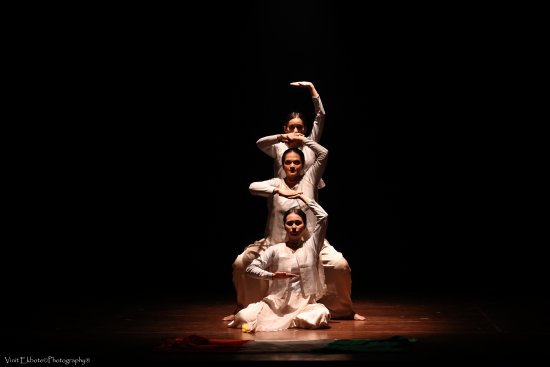 Gandhi Gita The 3rd presentation was 'Gandhi Gita'. The driving force of this presentation is the reflection of the essence of Eternal Truth - 'tat - sat' ('That is truth') of Mahatma Gandhi's 'My Experiments with Truth' and the immortal Bhagavad Gita. This presentation has been researched, conceptualized and choreographed by Uma Anantani and the artistic direction is by Uma Anantani and Shivangee Vikram. The music composition is by Jayan Nair and the production was supported by the Ministry of Culture, Government of India. The presentation began with a soulful Dhrupad which depicts the dilemma of Gandhiji - Dualism, the conflicts - both internal and external. Movements mirroring the 'self' and the fight with the inner conflicts that can be won over only by control over the indriya-s, were depicted in a flowing manner. Juxtaposed to this, was Arjuna's dilemma in the Kurukshetra war, where he requests Lord Krishna to place his chariot in the middle of the two armies "senayor ubhayor madhye..." (Gita chapter1). Gandhiji too believed in facing problems, being in the middle of 'duvidhaa'. The recitation of the jati in three speeds happening simultaneously, overlapping each other portrayed effectively the turmoil of the mind, the racing of thoughts, the conflicts at various levels and its final culmination signifying clarity of the mind - all depicted through the harmony of the movements of the dancers symbolizing harmony with the 'self'. The path leading to the truth is not straight but crooked and warped. The complexity of the search for truth requiring immense efforts was depicted through abstract yet meaningful movements by the dancers. It was a visual treat to watch well trained dancers using the nritta technique to suggest such a lofty concept! 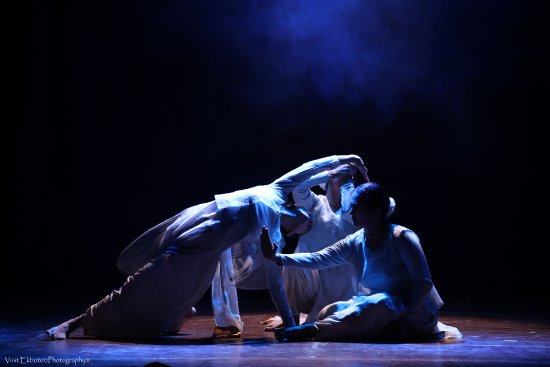 Gandhi Gita In the process of the search for truth, detachment plays a very important role. The verse from the Bhagavad Gita, "sukha duhkhe same kritva..." (Ch.2) was delineated using svaras, again through focussed use of nritta. The final realization of the soul, 'so ham' - 'I am that', the final journey of the 'Mahatma' whose only quest was universal peace was depicted in the verse from the Gita, "nainam chindanti shastraani..." (Ch.2). The tri colour is used in the choreography to depict Mahatma Gandhi as the 'karmaveera' (orange), 'bhumiputra' (green) and 'shantidhoot' (white). Such a Mahatma cannot 'leave' this world, who was not just a freedom fighter but 'A living Gita'. 'Anveshan' is a production involving refreshing choreography, stimulating music and energizing lights. There were moments when one could witness chaste Bharatanatyam, although the choreography also included 'movements based on Bharatanatyam'. Shivangee Vikram is endowed with a good stage presence and a beautiful form. Her abhinaya is endearing and her good grasp over tala is visible. A little more focus on nritta, especially her araimandi and strength in footwork is desirable. The two talented dancers Mrinalini and Khushi added to the vibrancy of the production. The lights by Parth Raval were very aesthetic and communicative. The lights were 'choreographed' to blend with the choreography of the dance movements, the music and the themes of presentations. In totality, Dr. Uma Anantani's 'Anveshan' appealed not only to the eyes and the ears but also the mind and the soul. 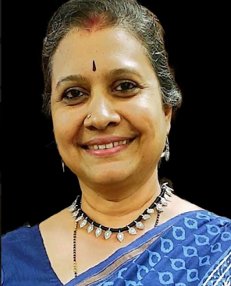 Dr. Meenakshi Iyer Gangopadhyay is an Associate Professor in Dance at Nalanda Nritya Kala Mahavidyalaya. A practitioner of Bharatanatyam, she is also a dance academician, research scholar and choreographer. |